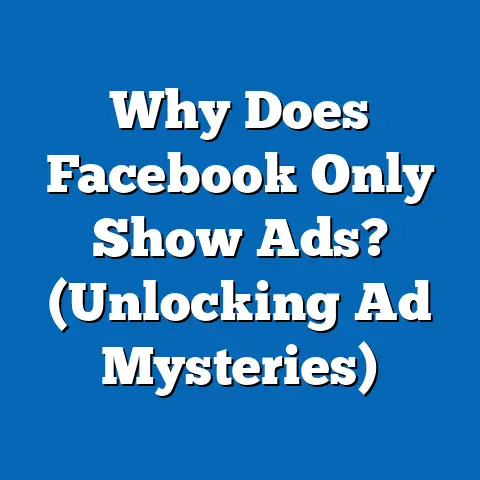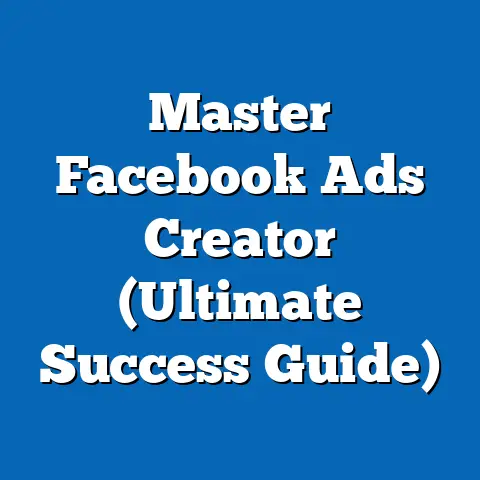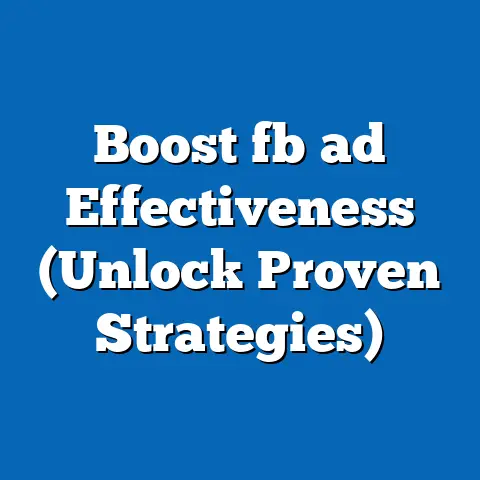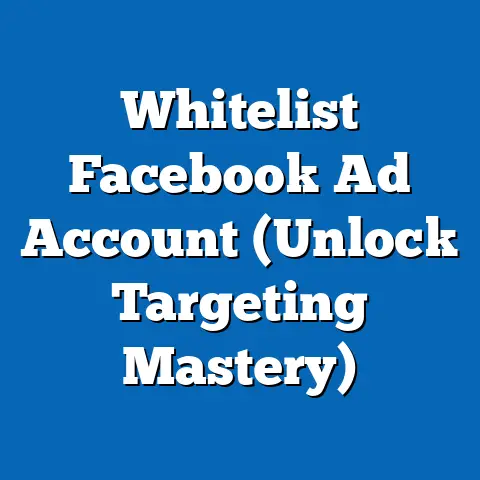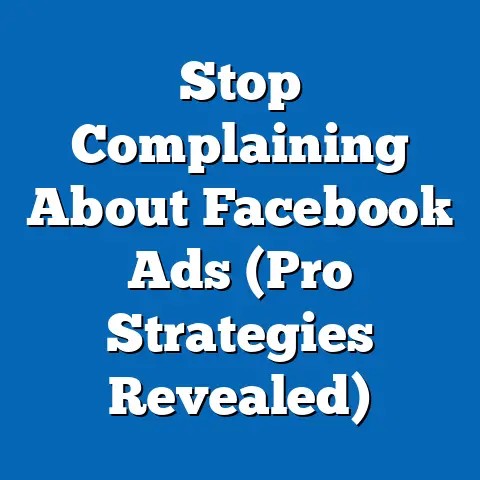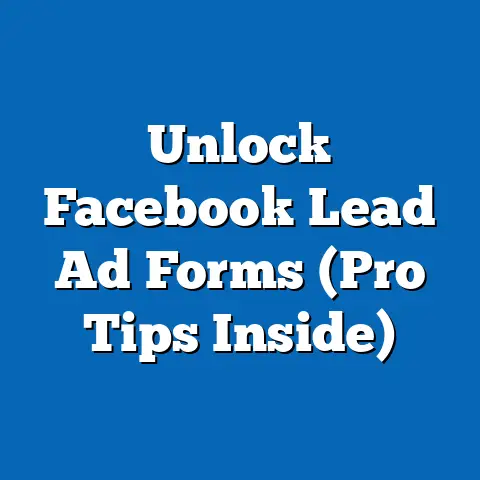Transform Facebook Ads Text for Maximum Impact (Pro Tips)
I’ve always believed that marketing, at its core, is an art form. It’s about taking something ordinary and transforming it into something extraordinary, something that resonates with people on a deeper level. Think about flooring, for example. It’s not just a functional part of a building; it’s a canvas that sets the tone for the entire space. The right wood, tile, or carpet can evoke feelings of warmth, luxury, or even playfulness. Similarly, in the digital world, your Facebook ad text is your canvas. It’s your opportunity to create a masterpiece that captures attention, conveys value, and ultimately, drives action.
Just as an artist meticulously chooses their colors and textures, you need to carefully craft your ad text to speak directly to your audience. In this guide, I’ll share pro tips that will help you transform your Facebook ads text from mundane to magnificent, ensuring it resonates with your audience and delivers the results you’re looking for.
1. Understanding Your Audience: Knowing Your Canvas
Before an artist even touches a brush to canvas, they have a vision. They understand the message they want to convey and the audience they want to reach. The same principle applies to Facebook ads. You can’t write effective ad text without a deep understanding of your target audience.
Why It Matters:
Imagine trying to sell luxury cars to college students. Your messaging would be completely off the mark. Understanding your audience allows you to tailor your language, tone, and overall message to resonate with their specific needs, desires, and pain points.
How to Do It:
- Demographic Insights: Facebook Ads Manager provides a wealth of demographic data, including age, gender, location, education, and job titles. Use this information to create a basic profile of your ideal customer.
- Interests: Explore the interests and behaviors of your target audience. What pages do they like? What groups are they members of? What topics do they engage with? Facebook’s detailed targeting options allow you to pinpoint these interests.
- Pain Points: What problems are your potential customers facing? What are their frustrations? Understanding their pain points allows you to position your product or service as the solution.
- Audience Personas: Create detailed audience personas that represent your ideal customers. Give them names, backgrounds, and specific goals. This will help you visualize who you’re writing for.
Examples:
- Formal vs. Casual: If you’re targeting business professionals, a formal and professional tone might be appropriate. However, if you’re targeting a younger audience on TikTok, a more casual and playful tone might be more effective.
- Emotional vs. Logical: For products that appeal to emotions (e.g., travel, entertainment), emotional language can be powerful. For products that require careful consideration (e.g., financial services, software), a more logical and data-driven approach might be better.
Tools & Methods:
- Facebook Insights (Meta Business Suite): This tool provides valuable data about your audience, including demographics, interests, and behaviors.
- Audience Personas: Create detailed profiles of your ideal customers based on your research.
- Surveys & Polls: Directly ask your audience about their needs and preferences.
My Experience:
I once worked with a client selling high-end skincare products. Initially, their ad text focused on the scientific ingredients and technical benefits. While accurate, it wasn’t resonating with their target audience. After diving deeper into audience research, we discovered that their customers were primarily concerned with looking and feeling confident. We revamped the ad text to focus on the emotional benefits – how the products could help them achieve radiant skin and boost their self-esteem. The results were dramatic, with a significant increase in click-through rates and conversions.
Takeaway:
Understanding your audience is the foundation of effective ad text. Take the time to research their needs, desires, and pain points, and tailor your message accordingly.
2. The Power of Headlines: The Title of Your Masterpiece
In the art world, the title of a piece can be just as important as the artwork itself. It’s the first thing viewers see, and it sets the stage for their experience. Similarly, your Facebook ad headline is your first opportunity to grab attention and entice people to learn more.
Why It Matters:
In a crowded newsfeed, your headline needs to stand out. It needs to be compelling enough to stop users from scrolling and pique their curiosity.
Pro Tips:
- Use Numbers: Numbers are naturally eye-catching and can add credibility to your claims. Examples: “5 Proven Strategies,” “10 Must-Have Gadgets.”
- Ask Questions: Questions can engage users and make them think. Examples: “Are You Tired of X?” “Want to Learn How to Y?”
- Emotional Triggers: Tap into emotions like curiosity, excitement, fear, or urgency. Examples: “Don’t Miss Out!” “The Secret to…” “Finally Revealed!”
- Highlight Benefits: Focus on what the user will gain by clicking on your ad. Examples: “Get More Leads,” “Save Time & Money,” “Transform Your Life.”
- Keep it Concise: Aim for a headline that is clear, concise, and easy to understand at a glance.
Examples of Effective Headlines:
- “Lose Weight in 30 Days: The Proven Method” (Numbers, Benefit)
- “Are You Making These Common SEO Mistakes?” (Question)
- “Finally! A Solution to Your Sleep Problems” (Emotional Trigger, Benefit)
- “Limited Time Offer: Get 50% Off!” (Urgency, Benefit)
Analysis:
Each of these headlines uses a different technique to grab attention and pique curiosity. They are clear, concise, and focus on the benefits to the user.
My Experience:
I remember struggling to get clicks on an ad for a new project management software. The original headline was simply “Project Management Software – Try It Free.” It was bland and uninspiring. After brainstorming, we came up with “Stop Wasting Time: Get Your Projects Done Faster.” This new headline, focusing on the key benefit of the software, resulted in a 3x increase in click-through rates.
Takeaway:
Your headline is your first impression. Make it count. Use numbers, questions, emotional triggers, and highlight benefits to grab attention and entice users to click.
3. Crafting Compelling Copy: The Story Behind the Art
While the headline grabs attention, the body copy is where you tell the story. It’s where you build interest, create desire, and ultimately, inspire action.
The AIDA Model:
The AIDA model is a classic copywriting framework that can be applied to Facebook ads:
- Attention: Grab the user’s attention with a compelling headline and visual.
- Interest: Keep them engaged with interesting and relevant information.
- Desire: Create a desire for your product or service by highlighting its benefits.
- Action: Tell them exactly what you want them to do (e.g., “Click here,” “Learn More,” “Shop Now”).
Techniques for Compelling Body Text:
- Storytelling: People love stories. Use storytelling to connect with your audience on an emotional level. Share customer testimonials, case studies, or even personal anecdotes.
- Benefits Over Features: Focus on the benefits of your product or service, rather than just listing its features. For example, instead of saying “Our software has advanced reporting features,” say “Get clear insights into your business with our easy-to-use reporting tools.”
- Social Proof: Use social proof to build trust and credibility. Include customer reviews, testimonials, or mentions of awards or recognition.
- Use “You” Language: Speak directly to the user by using “you” language. This makes your message more personal and engaging.
- Create Urgency: Use language that creates a sense of urgency, such as “Limited Time Offer,” “While Supplies Last,” or “Don’t Miss Out!”
Brevity and Clarity:
In the fast-paced world of social media, brevity is key. Get to the point quickly and use clear, concise language. Avoid jargon or technical terms that your audience might not understand.
My Experience:
I once worked on an ad campaign for a local restaurant. The original ad copy was lengthy and focused on the restaurant’s history and awards. While impressive, it wasn’t driving results. We shortened the copy and focused on the mouthwatering food and the welcoming atmosphere. We also included a strong call to action: “Treat Yourself Tonight! Book Your Table Now.” This simple change resulted in a significant increase in reservations.
Takeaway:
Craft compelling body copy that tells a story, highlights benefits, and inspires action. Keep it brief, clear, and focused on the user.
4. Utilizing Emojis and Formatting: Adding Visual Appeal
Just as an artist uses color and composition to create visual appeal, you can use emojis and formatting to make your ad text more engaging and readable.
Emojis:
Emojis can add visual flair and convey emotions in a way that words sometimes can’t. They can also make your ad text more relatable and engaging, especially for younger audiences.
Tips for Using Emojis:
- Use them Sparingly: Don’t overdo it. Too many emojis can be distracting and make your ad look unprofessional.
- Choose Relevant Emojis: Make sure the emojis you use are relevant to your message and target audience.
- Use them to Highlight Key Points: Emojis can be used to draw attention to important information.
Formatting:
Proper formatting can significantly improve the readability of your ad text.
Tips for Formatting:
- Use Bullet Points: Bullet points can break up long blocks of text and make it easier to scan.
- Use Line Breaks: Use line breaks to create white space and improve readability.
- Use Capitalization: Use capitalization to highlight key words or phrases.
- Use Bold Text: Use bold text to emphasize important information.
My Experience:
I once tested two versions of an ad for an online course. One version was plain text, while the other included emojis and formatting. The version with emojis and formatting had a 20% higher click-through rate.
Takeaway:
Emojis and formatting can add visual appeal and improve the readability of your ad text. Use them strategically to enhance your message and engage your audience.
5. A/B Testing Your Ad Text: Refining Your Art
Even the most talented artists experiment with different techniques and styles. Similarly, you should always be testing different versions of your ad text to see what resonates best with your audience.
Why It Matters:
A/B testing allows you to identify which elements of your ad text are most effective. It’s a data-driven way to optimize your campaigns and improve your results.
The A/B Testing Process:
- Set Clear Goals: What do you want to achieve with your A/B test? Do you want to increase click-through rates, conversions, or engagement?
- Create Variations: Create two or more versions of your ad text with slight variations. For example, you might test different headlines, body copy, or calls to action.
- Run Your Test: Use Facebook Ads Manager to run your A/B test. Make sure to allocate enough budget and time to gather statistically significant data.
- Analyze Results: Once your test is complete, analyze the results to see which version performed best.
- Implement the Winning Version: Implement the winning version of your ad text in your ongoing campaigns.
Real-World Examples:
Many brands have successfully optimized their ad text through A/B testing. For example, a clothing retailer might test different headlines to see which one generates the most clicks. A software company might test different calls to action to see which one leads to the most sign-ups.
My Experience:
I once ran an A/B test on an ad for a lead generation campaign. We tested two different headlines: “Get a Free Quote” and “Find the Best Price.” The “Find the Best Price” headline generated a 30% higher click-through rate and significantly more leads.
Takeaway:
A/B testing is essential for optimizing your ad text and improving your results. Continuously test different variations to see what resonates best with your audience.
6. Adapting to Trends and Changes: Staying Relevant
The art world is constantly evolving, with new trends and styles emerging all the time. Similarly, the world of social media is dynamic, and marketers need to stay updated with the latest trends and platform changes.
Why It Matters:
What worked yesterday might not work today. You need to be flexible and adaptable in your approach to ad text to keep it fresh and relevant.
Staying Updated:
- Follow Industry Blogs and Newsletters: Stay informed about the latest trends and best practices in social media marketing.
- Monitor Facebook’s Updates: Facebook is constantly rolling out new features and updates that can affect ad performance.
- Analyze Your Data: Continuously monitor your ad performance and make adjustments as needed.
Flexibility in Ad Copy:
Be prepared to adjust your ad copy in response to current events, seasonal themes, or changes in your target audience’s preferences.
My Experience:
During the COVID-19 pandemic, I had to completely revamp the ad copy for several of my clients. We shifted our messaging to focus on empathy, support, and the importance of staying connected. This approach resonated with our audience and helped us maintain positive relationships during a difficult time.
Takeaway:
Stay updated with the latest trends and platform changes, and be prepared to adapt your ad copy accordingly. Flexibility is key to long-term success.
Conclusion: The Art of Transformation
Just as an artist transforms a blank canvas into a compelling piece of art, you can transform your Facebook ads text into a powerful tool for communication and engagement. By understanding your audience, crafting compelling copy, utilizing emojis and formatting, A/B testing your ads, and adapting to trends and changes, you can create ads that resonate with your target audience and drive meaningful results.
Remember, your ad text is your opportunity to tell a story, connect with your audience on an emotional level, and inspire action. Embrace the art of transformation, and watch your Facebook ads take flight. Much like the art of flooring design, the right approach can create a lasting impression and drive meaningful engagement. Now go create your masterpiece!

